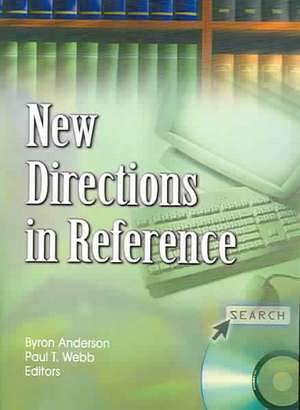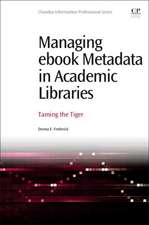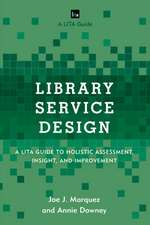New Directions in Reference
Autor Bryon D. Andersonen Limba Engleză Paperback – 11 iul 2006
Librarians work in an environment of constant change created by new technology, budget restraints, inflationary costs, and rising user expectations. New Directions in Reference examines how they can use new and innovative methods to design and deliver traditional reference services in a wide range of settings. The book’s contributors relate first-hand experiences in libraries large and small, public and academic, and urban and rural dealing with a variety of changes, including virtual reference, music reference, self-service interlibrary loan, e-mail reference, and copyright law.
Change isn’t new to libraries but the accelerated pace of change is. Traditional lines that have existed between library departments have been erased and traditional notions about general and specialized reference services have been reconsidered. New Directions in Reference documents how librarians are re-thinking their roles and responsibilities to keep pace with the ongoing process of evolution that borders on revolution.
New Directions in Reference examines:
- the skills needed to manage and evaluate virtual reference services
- the basics of modern copyright law and the Digital Millennium Copyright Act (DMCA)
- the changes in users, sources, and modes of access in music reference services
- the use of interlibrary loan management software that allows patrons to request, track, and renew borrowed materials online
- the “Ask-A-Librarian” e-mail reference service
- the Government Printing Office and government information online
- and much more!
| Toate formatele și edițiile | Preț | Express |
|---|---|---|
| Paperback (1) | 188.08 lei 6-8 săpt. | |
| Taylor & Francis – 11 iul 2006 | 188.08 lei 6-8 săpt. | |
| Hardback (1) | 497.26 lei 6-8 săpt. | |
| Taylor & Francis – 19 iul 2006 | 497.26 lei 6-8 săpt. |
Preț: 188.08 lei
Preț vechi: 274.50 lei
-31% Nou
Puncte Express: 282
Preț estimativ în valută:
35.99€ • 39.08$ • 30.23£
35.99€ • 39.08$ • 30.23£
Carte tipărită la comandă
Livrare economică 22 aprilie-06 mai
Preluare comenzi: 021 569.72.76
Specificații
ISBN-13: 9780789030894
ISBN-10: 0789030896
Pagini: 170
Dimensiuni: 148 x 210 x 11 mm
Greutate: 0.31 kg
Ediția:1
Editura: Taylor & Francis
Colecția Routledge
Locul publicării:Oxford, United Kingdom
ISBN-10: 0789030896
Pagini: 170
Dimensiuni: 148 x 210 x 11 mm
Greutate: 0.31 kg
Ediția:1
Editura: Taylor & Francis
Colecția Routledge
Locul publicării:Oxford, United Kingdom
Cuprins
- Introduction (Byron Anderson and Paul T. Webb)
- NEW ROLES FOR LIBRARIANS
- Virtual Reference: A Reference Question Is a Reference Question…Or Is Virtual Reference a New Reality? New Career Opportunities for Librarians (Mary-Carol Lindbloom, Anna Yackle, Skip Burhans, Tom Peters, and Lori Bell)
- Evolving Reference, Changing Culture: The Dr. Martin Luther King Jr. Library and Reference Challenges Ahead (Harry Meserve)
- Current Issues in Music Reference (Michael Duffy IV)
- A Primer on Copyright Law and the DMCA (Byron Anderson)
- IMPACT OF TECHNOLOGY
- Self-Service Interlibrary Loan: A Primer for Reference Staff (Roberta Burk)
- From Novelty to Necessity: Impact of the PDA Experience on Medical Libraries (Peg Burnett and Jo Dorsch)
- E-Mail Reference Evaluation: Using the Results of a Satisfaction Survey (Leanne M. VandeCreek)
- ISSUES IN LIBRARY SERVICES
- How the GPO Got Its Groove Back: Government Printing Office and Government Information
- Reference Services in Rural Libraries (Amanda E. Standerfer)
- Index
- Reference Notes Include
Descriere
Librarians work in an environment of constant change created by new technology, budget restraints, inflationary costs, and rising user expectations. New Directions in Reference examines how they can use new and innovative methods to design and deliver traditional reference services in a wide range of settings. The book's contributors relate first-hand experiences in libraries large and small, public and academic, and urban and rural dealing with a variety of changes, including virtual reference, music reference, self-service interlibrary loan, e-mail reference, and copyright law.




















